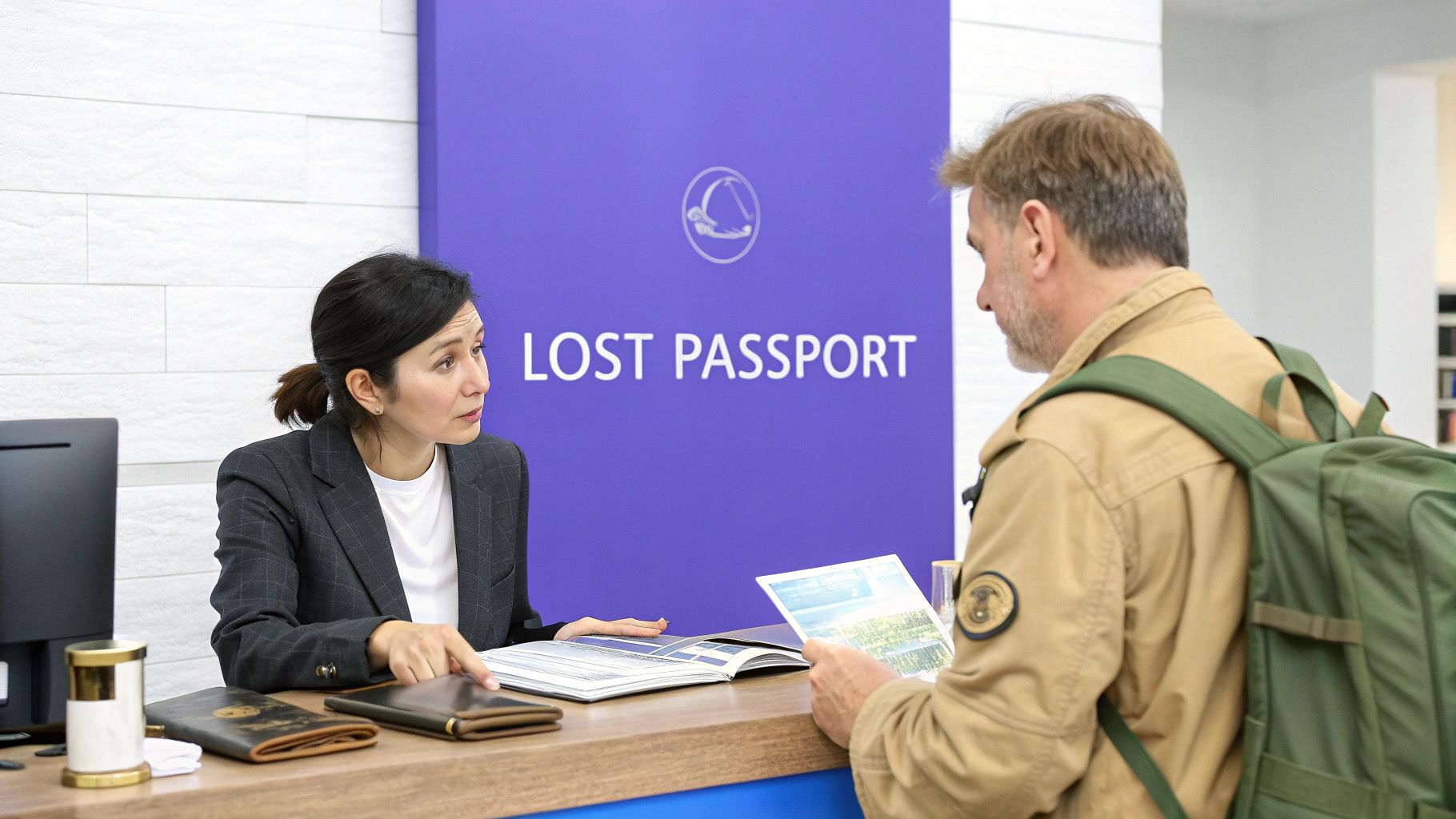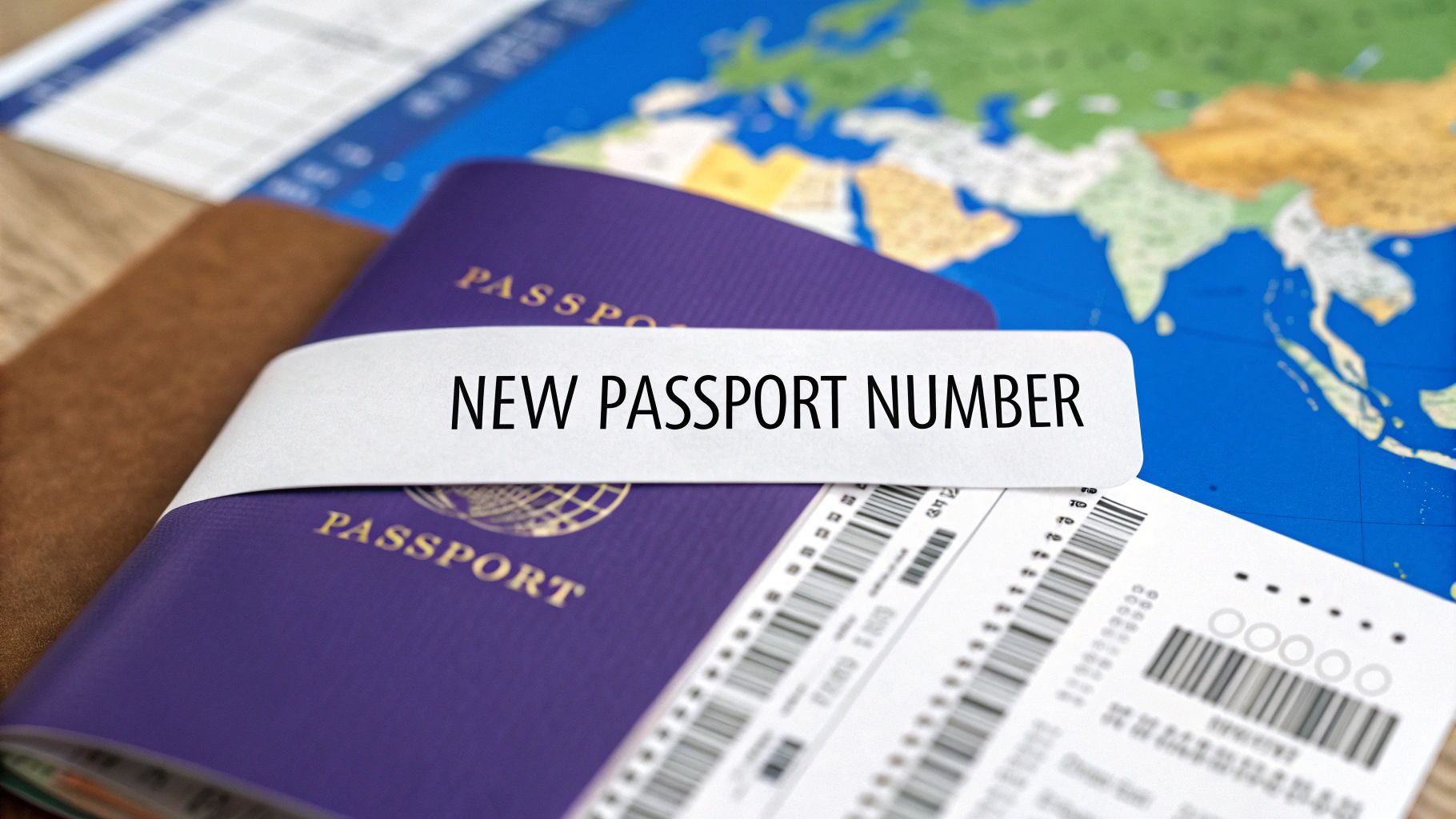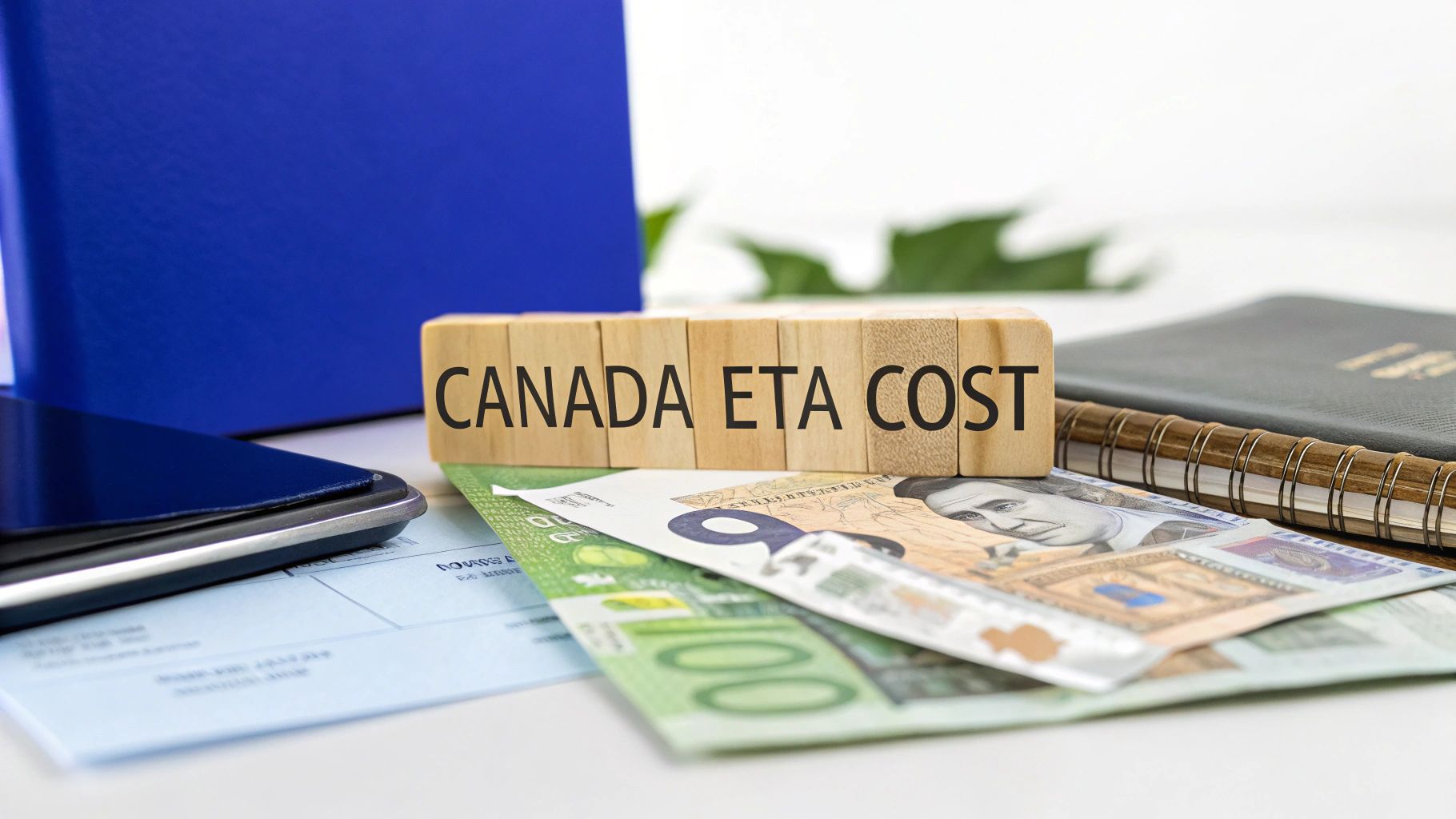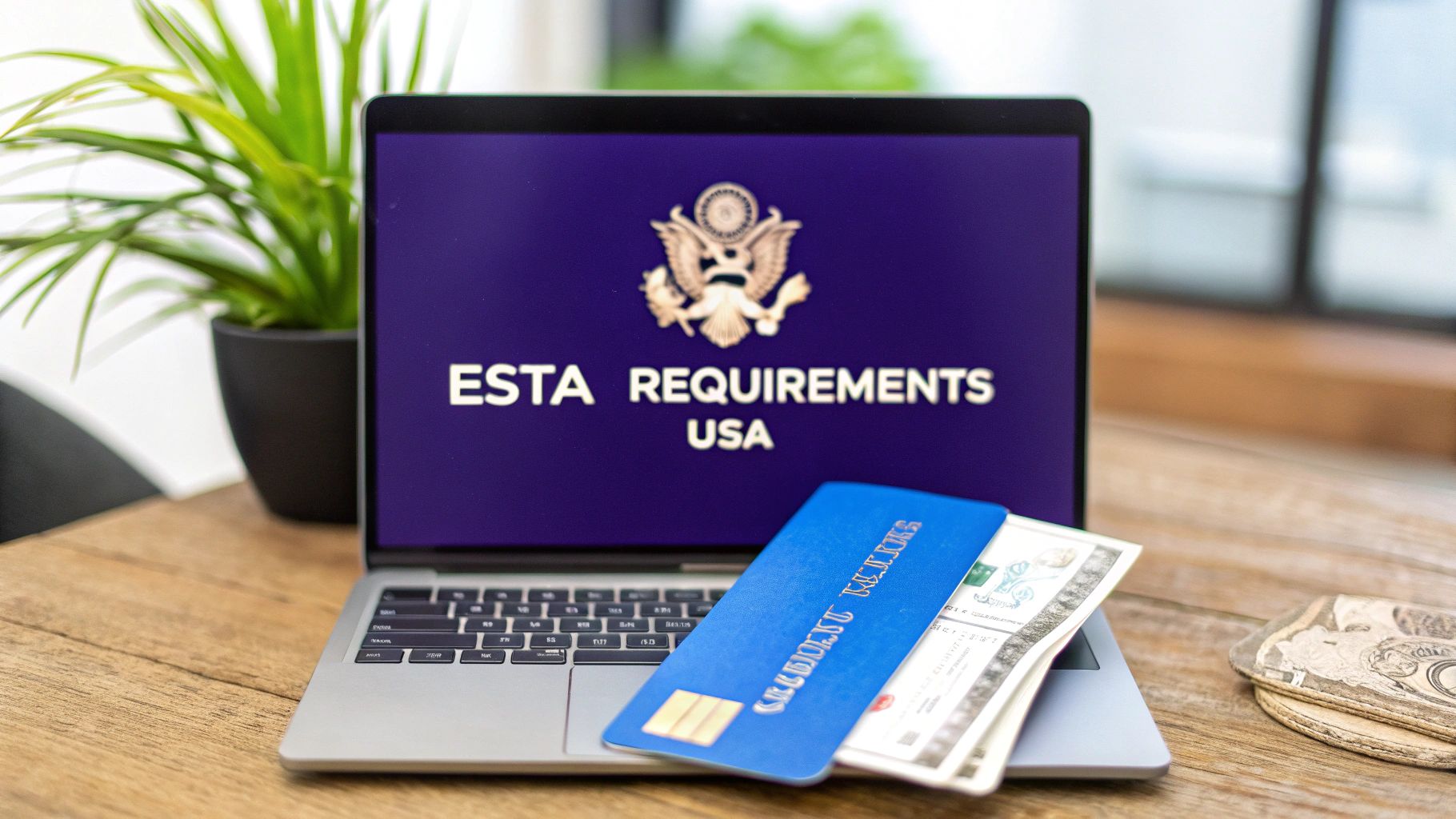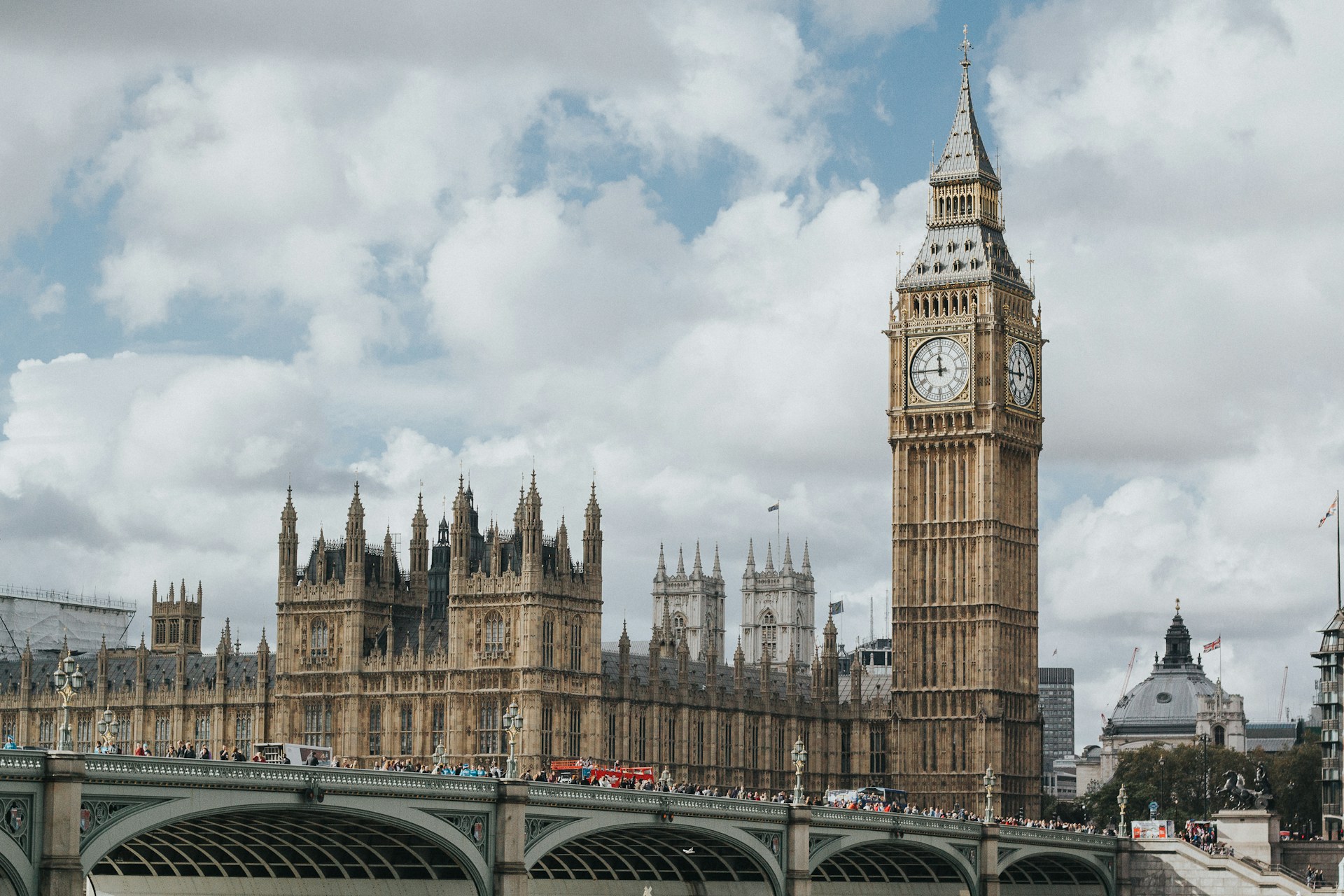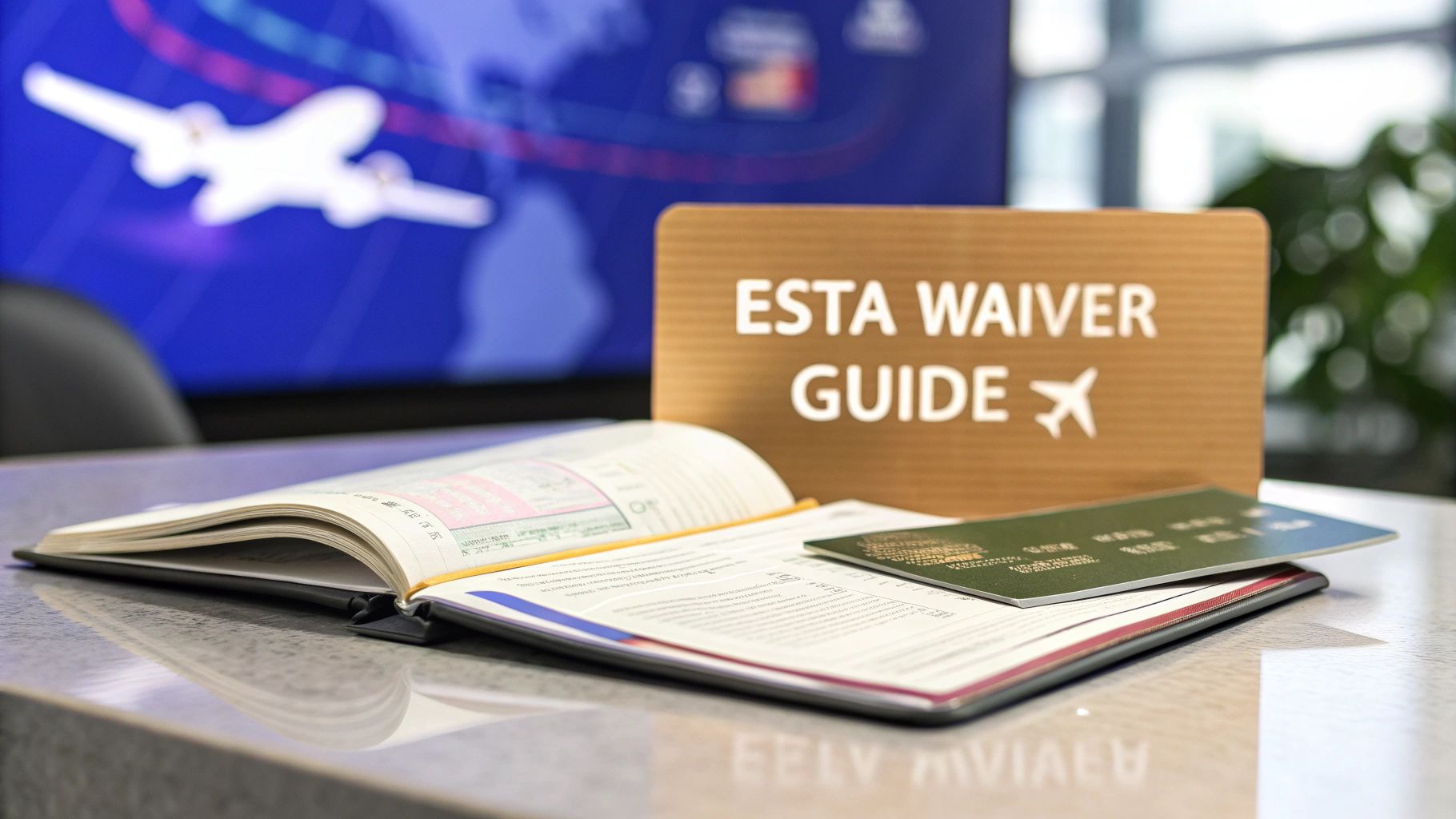
Your Guide to the US Waiver Program ESTA
The US Waiver Program ESTA is a digital travel pass that lets people from certain countries visit the United States without a traditional visa. If you're eligible, you can come for tourism or business for up to 90 days.
Think of the Visa Waiver Program (VWP) as a special fast-pass lane for entering the U.S. And your ESTA? That’s the digital ticket that gets you into that lane.
Understanding the Visa Waiver Program and ESTA

Not long ago, planning a quick trip to the U.S. often meant a headache of paperwork, appointments at an embassy, and even an in-person interview just to get a travel visa. The U.S. Visa Waiver Program (VWP) was created to get rid of all that hassle for travelers from specific, trusted countries.
The VWP lets you skip the formal visa process for short stays. Instead of getting a stamp in your passport ahead of time, you simply apply for authorization online. This is where the Electronic System for Travel Authorization (ESTA) comes into play.
An approved ESTA is your mandatory key to visa-free travel to the United States. It’s also a smart security tool that allows U.S. authorities to screen travelers before they even get on a plane.
The Core Purpose of ESTA
At its heart, the ESTA system does two things: it boosts national security while making travel a whole lot smoother. By having travelers submit their info in advance, the Department of Homeland Security can flag potential issues early on. For you, it means a quicker and cheaper process than applying for a full-blown visa.
This system is built specifically for short trips, such as:
- Tourism: Vacations, visiting family or friends, or just exploring.
- Business: Attending a conference, negotiating a contract, or meeting with clients.
- Transit: Just passing through the U.S. on your way to another destination.
It's really important to remember that an ESTA is not a visa. It doesn't give you the same permissions. For example, you can't use an ESTA to work, enroll in school, or try to live in the U.S. permanently. For a closer look at the different types of travel permissions, check out our detailed guide on US visa types.
Who Is Eligible for the Program
Eligibility is everything. Only citizens from specific countries can use the VWP to travel to the U.S. for tourism or business for up to 90 days. As of 2025, the program includes 43 countries, mostly from Europe and Asia.
An approved ESTA is valid for two years and allows for multiple visits. However, if you plan to work, study, or stay longer than 90 days, you absolutely must get a standard visa instead.
Here’s a quick rundown of the essential details.
ESTA at a Glance Key Information
| Feature | Details |
|---|---|
| Purpose | Allows visa-free travel for tourism, business, or transit. |
| Duration of Stay | Up to 90 days per visit. |
| Validity | Approved ESTA is valid for two years or until your passport expires, whichever comes first. |
| Eligibility | For citizens of the 43 countries in the Visa Waiver Program. |
| Application Process | Fully online, must be completed before you travel. |
| What It's Not | It is not a visa. It does not permit work, long-term study, or residency. |
| Requirement | Mandatory for all eligible travelers arriving by air or sea. |
Ultimately, the ESTA system is a modern solution that strikes a great balance between security and convenience, making it easier for millions of people to visit the United States every year.
Are You Eligible for the VWP?
Before you get too deep into planning your American adventure, the very first step is figuring out if you qualify for the U.S. Visa Waiver Program (VWP). It’s not complicated—think of it as having two main requirements: your citizenship and the reason for your trip.
Getting these two things right from the start is the key to a smooth and painless application. The whole waiver program esta system is built on a foundation of trust and security between the United States and a select group of partner countries. If your country isn't on this special list, you'll have to go the traditional visa route instead.
The Two Pillars of VWP Eligibility
So, can you use the VWP? It boils down to two simple questions. First, are you a citizen of a participating country? Second, is your trip for an approved reason and short enough? Let’s break down exactly what that means.
1. Your Citizenship and Passport
Your nationality is the first hurdle. Only citizens or nationals of the 43 countries in the VWP can apply for an ESTA. This list is mostly made up of countries in Europe and the Asia-Pacific region that have strong diplomatic and security relationships with the U.S.
But just having the right citizenship isn't enough—you also need the right passport. You absolutely must have an e-passport with a biometric chip inside. This modern passport contains a small electronic chip that stores your photo and personal information, adding a crucial layer of security. Not sure if you have one? Just look for the small, rectangular symbol on the front cover.
2. Your Reason for Traveling
The VWP is strictly for short-term visits. Your travel plans have to fit neatly into one of three categories:
- Tourism: This covers everything from vacations and visiting friends or family to attending a wedding or just exploring American cities.
- Business: You can head to the U.S. to attend a conference, meet with business partners, or negotiate a contract.
- Transit: Just passing through the U.S. on your way somewhere else? The VWP has you covered.
Here’s the big one: your stay cannot be longer than 90 days. This is a hard-and-fast rule. Overstaying can get you banned from using the VWP in the future, so take it seriously.
Key Takeaway: That 90-day limit is non-negotiable. Trying to find a paid job, enrolling in a university course for credit, or working as a journalist are all strictly forbidden on the VWP. If your plans involve any of those activities, you need to apply for the correct type of U.S. visa.
Other Things That Can Make You Ineligible
Even if you have the right passport and your trip is for the right reason, a few other things can still disqualify you. These rules are all about security, and U.S. authorities don't bend them.
You’ll likely need to apply for a visa instead of an ESTA if you:
- Have traveled to or been in countries like Iran, Iraq, North Korea, Sudan, or Syria on or after March 1, 2011 (though some exceptions exist for diplomatic or military service).
- Have a criminal record, especially for serious offenses.
- Have been denied entry into the U.S. before or have overstayed a previous visit.
- Have certain communicable diseases.
The VWP is constantly evolving based on U.S. national security priorities. For example, Argentina was removed from the program years ago due to economic instability that officials worried would lead to visitors overstaying. More recently, the Visa Waiver Program Improvement and Terrorist Travel Prevention Act of 2015 added stricter rules. You can dig into the details by exploring the history of the Visa Waiver Program on your own.
Being honest with yourself about these rules is the best way to avoid a denied application. For a closer look at the application itself, check out our guide on how to apply for a US ESTA now.
How to Navigate the ESTA Application
Let’s be honest, filling out official travel forms can feel a little intimidating. But it doesn't have to be. We're going to walk through the ESTA application step-by-step, turning it from a confusing chore into a simple checklist. The real secret to a quick approval is having all your information ready before you even start.
Think of it like getting your ingredients ready before you start cooking. A few minutes of prep work now will save you a headache later and drastically reduce the chances of a simple mistake causing a big problem.
This visual guide breaks down the core requirements you need to meet before you can even apply.
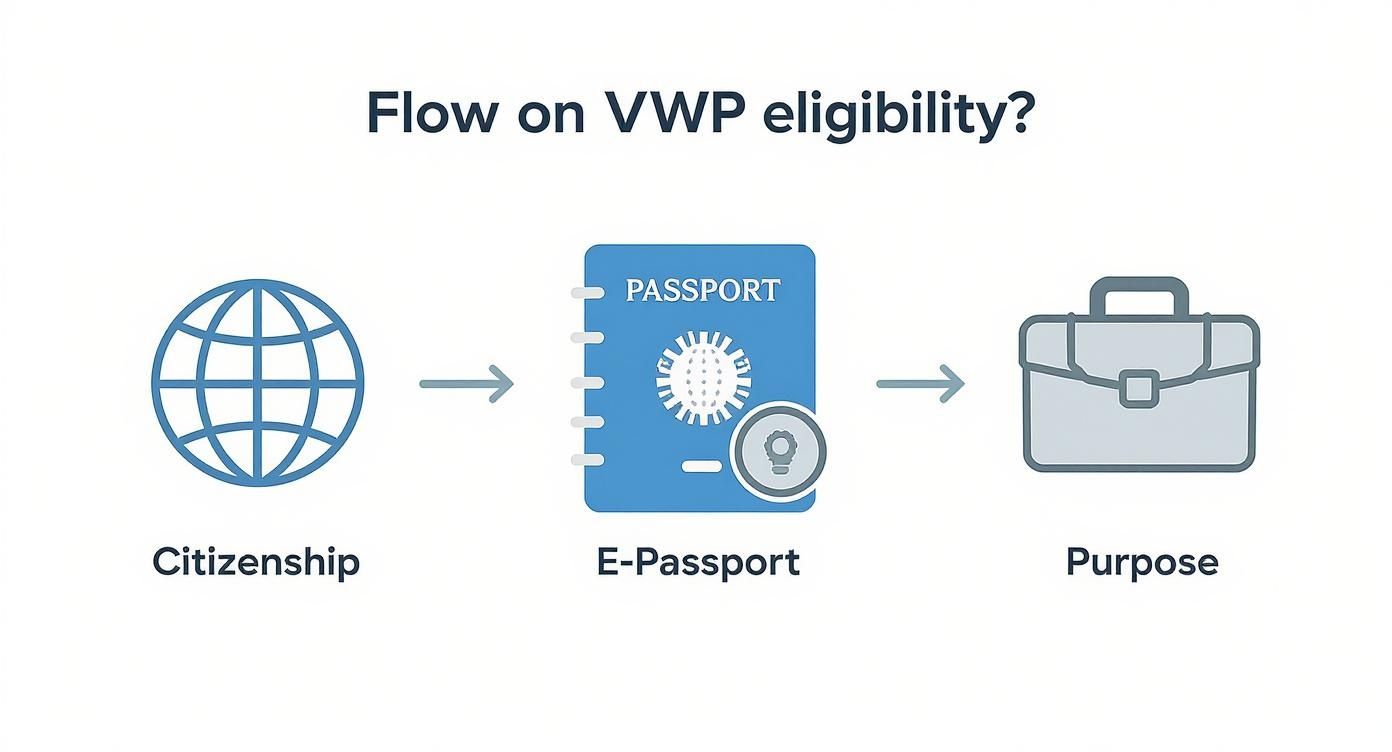
As you can see, confirming your citizenship, making sure you have an e-Passport, and knowing your travel purpose are the first hurdles. Once you clear those, you're ready to dive in.
Essential Information to Gather
To make this as painless as possible, have these things right in front of you:
- Your Valid E-Passport: You’ll need the passport number, issue date, and expiration date. Double-check that it has the little biometric chip symbol on the cover.
- Travel Itinerary (if you have one): It’s not always required, but having your flight info and the address of where you're staying in the U.S. (even just the first hotel) makes things smoother.
- Employment Details: Be ready to enter the name, address, and phone number of your current or most recent employer.
- Payment Method: You'll need a valid credit card (Mastercard, VISA, American Express, Discover) or a PayPal account to cover the application fee.
With these items on your desk, you can tackle the form confidently and accurately.
Breaking Down the Application Form
The official ESTA form is split into a few manageable sections. Accuracy is everything here. A simple typo—like swapping two numbers in your passport ID—is enough to get your application denied or cause issues when you land.
Here are the main parts:
- Applicant Information: This is where you put your name, birthdate, and gender. It must match your passport's main information page exactly. No nicknames.
- Passport Details: Carefully type in your passport number, country of citizenship, and the other details. This is how your approved ESTA gets electronically linked to your travel document.
- Travel Information: You’ll be asked why you're visiting (tourism or business) and for your U.S. contact or accommodation info. If your plans aren't set in stone, you can provide general information.
Following the form in this order helps you avoid the common slip-ups that catch many travelers off guard.
The Critical Eligibility Questions
The last, and arguably most important, part of the application is a series of simple "yes" or "no" questions. These are designed to screen for any security or health risks. The questions will touch on your criminal record, any past visa denials, and whether you've traveled to certain countries.
Important Reminder: Answer every single question truthfully. A wrong "yes" or "no," even by accident, can be seen as misrepresentation. This could lead to a denied ESTA and make future travel to the U.S. much more difficult. Take your time and read each one.
Submitting the application can be nerve-wracking, especially with the strict rules of the waiver program ESTA. If you're worried about making a mistake or just want a second set of expert eyes on your details, you might consider using an assistance service. You can explore ESTA application assistance options to see how a professional service can help guarantee accuracy and boost your approval odds.
Once you’ve filled everything out, you’ll head to the payment section and submit your application for review.
Common Application Mistakes You Need to Avoid
An ounce of prevention is worth a pound of cure, especially with your ESTA application. Even the tiniest error can lead to a denial or, worse, a headache when you land in the United States. Think of this section as your guide to sidestepping the common traps that catch even the most careful travelers.
Navigating the waiver program ESTA application is all about precision. Once you know what trips people up, you can approach the form with the confidence needed to get that fast, successful approval.
Passport Information Precision
The most common reason for rejection is surprisingly simple: a typo in your passport details. Your ESTA is electronically tethered to your passport, so the information has to match perfectly.
- Name Misspellings: Your name must be entered exactly as it appears in the Machine-Readable Zone (MRZ) of your passport. That’s the two lines of text, numbers, and chevrons
(<<<<)at the bottom of the photo page. No nicknames, no shortcuts. - Incorrect Passport Number: A single wrong digit or letter can kill your application. It’s so easy to mix up the letter 'O' with the number '0', or 'I' with '1'. Double- and triple-check this field.
- Wrong Dates: This one is easy to overlook. Make sure your passport's issue and expiration dates are typed in correctly. An invalid date is an automatic red flag for the system.
These might seem like small details, but to an automated system, they're everything. An ESTA with the wrong passport number is essentially useless, as it won't connect to you at the airport.
Misinterpreting the Eligibility Questions
Near the end of the form, you’ll hit a series of "yes" or "no" security questions. These cover things like your criminal background, previous visa problems, and travel to certain countries. Rushing this section is a recipe for disaster.
Crucial Tip: Read every single question carefully and answer honestly. Answering "yes" by mistake can trigger an automatic denial, but answering "no" dishonestly is considered misrepresentation and could get you banned from future travel.
For instance, a question might ask if you’ve ever been arrested or convicted of a crime. This can be tricky, as a minor offense from years ago might feel irrelevant. If you find yourself hesitating, that’s a big sign you should seek professional guidance before answering.
For a deeper dive into making the whole process smoother, check out our article covering 7 essential tips to swiftly secure your ESTA approval.
Using Outdated or Incorrect Information
Life moves fast, and your application needs to reflect where you are right now. Using old information is another common mistake that’s easy to avoid.
- Old Passport Details: Just got a new passport? You must use the new one's information for your ESTA. Your old ESTA, linked to your expired passport, is no longer valid for travel.
- Incorrect Contact Information: Make absolutely sure your email address is correct. This is how you'll get your application status updates and, most importantly, your approval notification. A typo here means you could be left in the dark.
- Forgetting Dual Citizenship: If you're a citizen of more than one country, you have to declare it. Be sure to apply with the passport from the VWP-eligible country you plan to use for your trip.
By keeping these common pitfalls in mind, you dramatically increase your chances of getting approved on the first try. Taking an extra five minutes to review every field can save you hours of stress and keep your travel plans right on track.
Decoding Your ESTA Application Status
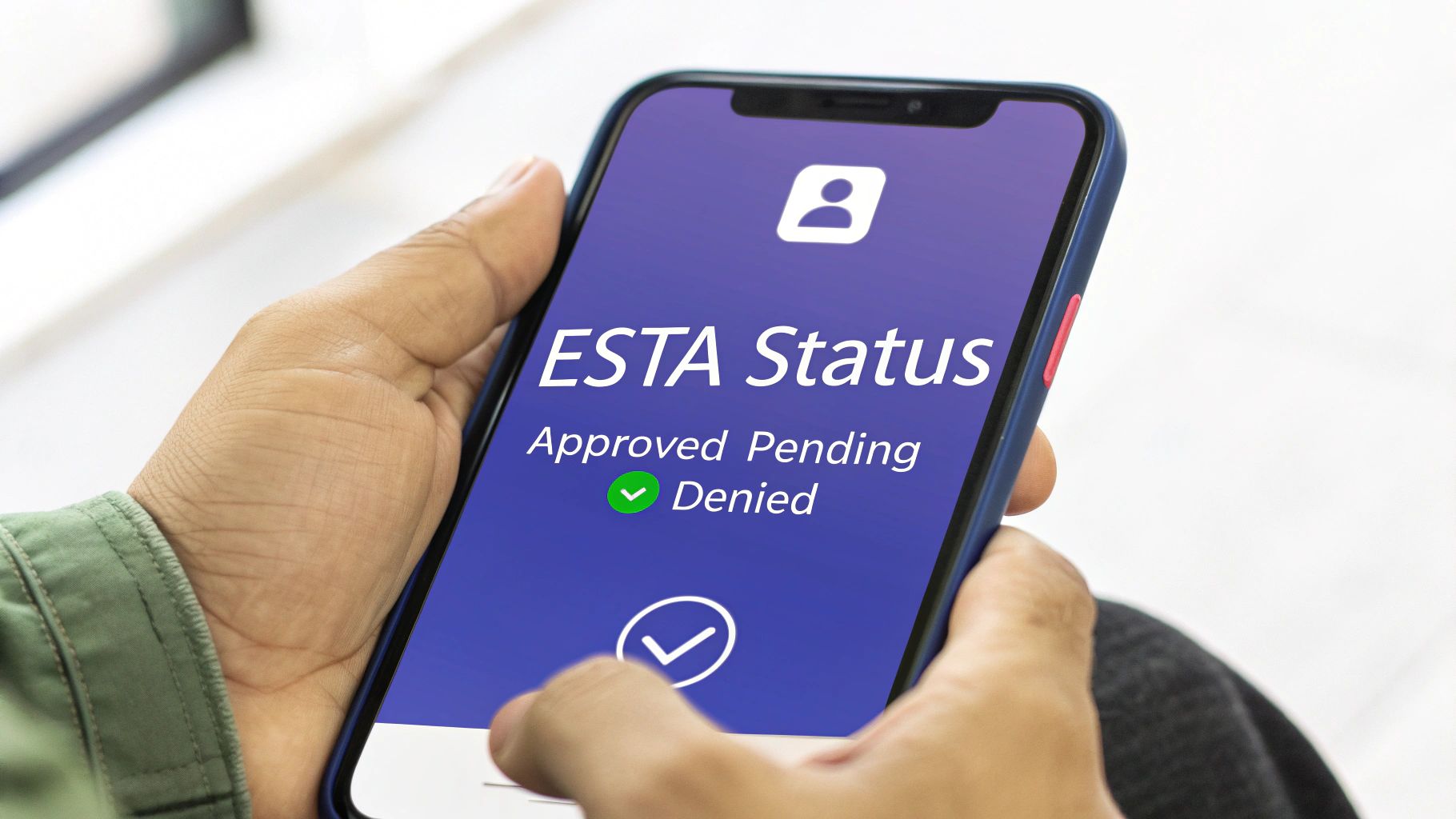
You’ve filled out the form, double-checked every field, and finally clicked "submit." Now comes the waiting game, which can feel a little nerve-wracking. But it doesn't have to be.
Understanding the different application statuses takes all the mystery out of the process. While most travelers get a decision almost instantly, it’s always smart to apply at least 72 hours before your flight. This gives the system enough time if your application needs a closer look.
Let's walk through the three possible outcomes and exactly what they mean for your trip.
Status 1: Authorization Approved
This is the green light you’ve been waiting for! "Authorization Approved" means you’re cleared to travel to the United States under the Visa Waiver Program.
Your ESTA is typically valid for two years from the approval date, or until your passport expires—whichever comes first. During this time, you can take multiple trips to the U.S. for stays of 90 days or less without having to reapply.
It’s a great idea to print a copy of your approval or save a screenshot on your phone. While your ESTA is linked to your passport electronically, having a backup gives you peace of mind.
Need to know when it's time for a new one? Check out our guide on how to renew your US ESTA visa waiver.
Status 2: Authorization Pending
Seeing "Authorization Pending" can be unsettling, but don't panic. This is a completely normal status and simply means your application is under review.
In most cases, you’ll have a final decision within 72 hours. Just check back on the official ESTA website periodically. The key here is patience—avoid the temptation to submit another application, as this can cause confusion and delays.
Status 3: Travel Not Authorized
"Travel Not Authorized" means your ESTA application was denied. It’s important to know this is not a permanent ban on entering the U.S. It just means you are not eligible to travel under the Visa Waiver Program at this time.
The system won't give you a specific reason for the denial. It could be anything from a simple mistake on the form to a past immigration issue. Your next step is to apply for a B-1 (business) or B-2 (tourist) visa directly through a U.S. Embassy or Consulate, which involves a more detailed application and an interview.
Understanding Your ESTA Application Status
When you hit submit, your application will fall into one of three categories. This table breaks down what each status means and what you should do next.
| Status | What It Means | Your Next Step |
|---|---|---|
| Authorization Approved | You are cleared to travel to the U.S. under the Visa Waiver Program. | Pack your bags! Print or save a copy of your approval for your records. |
| Authorization Pending | Your application is still under review and needs more time. | Check your status online again within 72 hours. Do not reapply. |
| Travel Not Authorized | You are not eligible to travel with an ESTA. | You must apply for a B-1 or B-2 visa at a U.S. Embassy or Consulate. |
No matter the outcome, knowing what to expect makes the process much smoother and helps you plan accordingly.
Your ESTA Questions Answered
Even when the application seems simple enough, real-world travel plans can throw you a curveball. The waiver program ESTA is designed to be user-friendly, but a few common questions always seem to pop up as people get ready to fly.
Let's clear up some of the most frequent points of confusion, from passport changes to the strict rules on what you can (and can't) do once you land in the States. Getting these answers straight will save you a world of last-minute stress.
What Happens If My ESTA Expires While I Am in the US?
This is a common worry, but the answer is refreshingly simple: your ESTA only needs to be valid on the day you enter the United States. That's it.
When you arrive, a U.S. Customs and Border Protection (CBP) officer grants you a stay of up to 90 days. Even if your ESTA's two-year validity happens to end during that 90-day window, you're in the clear. Your permission to stay is tied to the date stamped in your passport, not your ESTA's expiration date.
Just remember, you can't use that expired ESTA to re-enter the U.S. on your next trip. You'll need to apply for a fresh one.
Do I Need a New ESTA If I Get a New Passport?
Yes, absolutely. This one is a hard and fast rule with no exceptions.
Your approved ESTA is electronically locked to the specific passport number you applied with. If you get a new passport—whether your old one expired, was lost, or you changed your name—your current ESTA is instantly void.
Before you can travel to the U.S. again under the VWP, you have to submit a brand-new ESTA application using your new passport details.
Can I Work or Study in the US with an Approved ESTA?
A firm no. This is probably the most critical rule of the Visa Waiver Program, and breaking it can get you banned from future travel to the U.S.
The VWP is exclusively for short-term visits with a clear purpose:
- Tourism: Vacation, visiting family and friends, or attending social events.
- Business: Attending a conference, negotiating a contract, or meeting with business associates (as long as you aren't paid by a U.S. source).
- Transit: Just passing through the U.S. on your way somewhere else.
Any kind of work, paid or unpaid, is strictly forbidden. The same goes for enrolling in a university course for credit. If work or school is your main reason for visiting, you need to go through the proper channels and apply for the right visa, like an H-1B for work or an F-1 for students, at a U.S. Embassy.
What Is the Difference Between an ESTA and a Visa?
It's easy to mix these two up, but they are fundamentally different. Calling an ESTA a "visa" is a common mistake.
An ESTA is simply a travel authorization. It pre-screens you and gives you permission to board a flight to the U.S. A visa is a formal travel document, physically placed in your passport, that is required for people who aren't eligible for the VWP or who need to stay longer or do things the VWP doesn't allow.
The process couldn't be more different, either. You get an ESTA by filling out a quick online form, and you often get a decision in minutes. A visa application is a much heavier lift, requiring detailed paperwork, supporting documents, and a mandatory in-person interview at a U.S. Embassy or Consulate.
Think of it this way: an ESTA gets you to the door, but a visa gives you the key for a specific purpose like working, studying, or living there.
While the ESTA process is meant to be straightforward, a simple mistake can lead to delays or denials that put your entire trip at risk. And it's not just the U.S.—other countries have similar digital travel systems where accuracy is key. The UK and Canada, for example, have both rolled out their own Electronic Travel Authorization (ETA) systems for international travelers.
To simplify your UK ETA application and increase your chances of approval, consider using a third-party application assistance provider. To avoid delays and mistakes, the experts at AssistEntry can guide you through the entire process. Their service includes a full verification of your application, error-checking, and a compliance review to maximize your approval odds. Prices start from just $79, which includes the government fee.
To simplify your UK ETA application and increase your chances of approval, consider using AssistEntry’s UK ETA page — their experts guide you through the entire process, starting from just $79.
